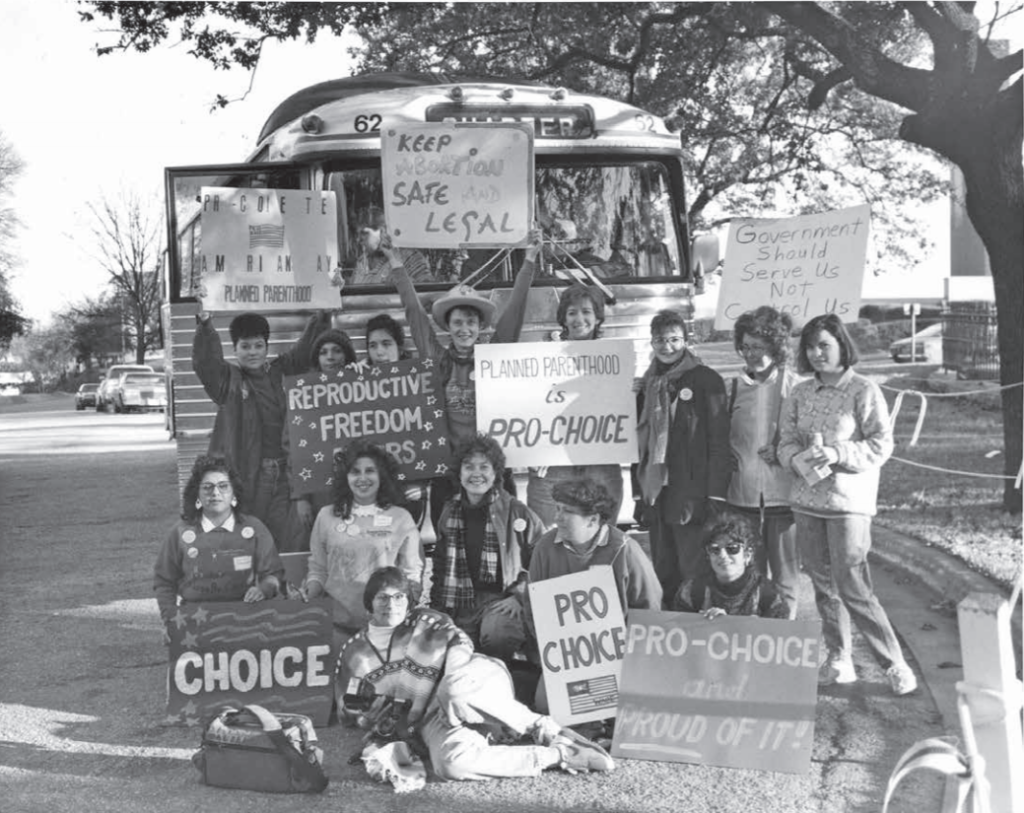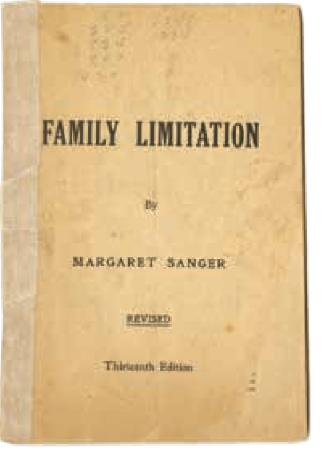By Vince Lee

Little would the world, let alone the Houston community, know that life for Planned Parenthood of Houston and Southeast Texas would begin on February 20, 1936, as the Maternal Health Center of Houston. The organization’s creation is recorded in a nondescript, brief, three-page Articles of Incorporation document issued by Harris County for the State of Texas, and archived in the Carey Shuart Women’s Research Collection in Special Collections at the University of Houston Libraries. The name, Maternal Health Center of Houston, was chosen with intentional care to avoid arousing controversy or suspicion, whereas anything associated with the term “birth control” would have been deemed offensive and taboo. Interestingly, the signatories of the little-known document, Mrs. Haywood Nelms, Mrs. George Heyer, and Mrs. J. Graham Flynn, were all women, which was amazing for the time period.

Per Article II of the Articles of Incorporation, “the purpose for which this corporation is formed is to establish and maintain a free medical clinic for the use and benefit of the mothers and prospective mothers of the City of Houston and to furnish to the mothers and prospective mothers of Houston free medical advice on maternal health and to erect and maintain all necessary buildings, structures, and grounds necessary to the operations of such clinic, all of the corporation’s activities to be of a charitable nature.”1 Even in the beginning, the language contained within the document showcased the hallmarks and attributes that defined the mission and vision of Planned Parenthood of Houston both locally and nationally in the coming years. Its initial board of directors consisted of twenty-six members, eighteen of whom were women from the Houston community. An impressive statistic as women comprised nearly 70 percent of the board.
Another interesting tidbit found in Article III of the Articles of Incorporation states that “The corporation shall exist for a period of fifty years from the date of filing of these articles of incorporation in the office of the Secretary of State of the State of Texas.” Whether fifty years was chosen as a nice round number that would ensure the organization’s existence until something more permanent took hold in the future is debatable. What is not up for debate is that, since the organization’s founding, it has persisted and continues to serve the Houston area thirty-four years beyond its stipulated time.
The history of Planned Parenthood of Houston cannot be discussed without including the history of Agnes Carter Nelms (1889-1967). Born in Barnum, Texas, she was the daughter of a wealthy East Texas lumberman, William Thomas Carter, who moved the family to Houston at the turn of the twentieth century. Although Agnes came from a family of wealth and privilege who ensured she was educated and well-traveled, as a young woman she performed social work in Houston communities, making her distinctly aware of the problems faced by poor women who could not afford the means of contraceptive choice and services available to the affluent. Well aware of the efforts and work of Margaret Sanger in the national birth control movement, Nelms wanted to bring that same advocacy to the local community. Serving as one of the first presidents of the Maternal Health Center of Houston from 1938-1941, she leveraged her connections with other prominent Houstonians (many of them women) to serve on the center’s inaugural board of directors, while encouraging others to donate funds to underwrite many of the operating costs and services provided to women visiting the clinic.

Sanger, known as the Mother of Birth
Control, circa 1923.
As a result of her work, Agnes Carter Nelms became known as the “Margaret Sanger of Texas.” She organized the Birth Control League of Texas, where eight additional Texas affiliates in Dallas, Fort Worth, Waco, Austin, San Antonio, San Angelo, El Paso, and Corpus Christi established their own Maternal Health Centers in addition to the one in Houston. Each affiliate operated autonomously but shared their information and best practices with each other. This network of affiliates formed the model later adopted by the Planned Parenthood Federation of America.
In 1942 the Maternal Health Center of Houston became known as the Planned Parenthood Center of Houston following a name change by the National American Birth Control League to Planned Parenthood Federation of America. Indigent clients within the Houston learned of the center and its services via word of mouth. From a historical timeline created by Hanni Orton and Phyllis Van Kerrebrook, over a thirty-three-year span from 1935-1968, Planned Parenthood of Houston and Southeast Texas was the “only organization in Harris County that provided family planning services at low cost. Fees were 50 cents for service or supplies — if the patients could afford it, otherwise they were free.”Additional documents contained within the organization’s archival collection include correspondence from the 1940s detailing Planned Parenthood’s early fundraising drives to raise much-needed capital — with early targets of $47,000 and $50,000 — to support the continued operations and services that Planned Parenthood of Houston provided to the community. In letters from the late 1970s and early 1980s past president, Phyllis Van Kerrebrook, expressed growing concerns of the federal government cutting funding to entitlement programs such as Title XX (Family Planning) that would affect funds Planned Parenthood depended on to provide services to low-income individuals.
Other letters from the 1990s detail the prevalence of violence occurring at the clinics and expressed staff concerns about the media fueling the violence through miscommunication it spread about Planned Parenthood and its affiliated clinics. Finally, the collection contains letters of advocacy and support on behalf of the community for much-needed funds and for political lobbying within the U.S. Congress and the national Planned Parenthood organization itself.

Parenthood Center on Fannin, circa 1989.
In August of 1994, Planned Parenthood of Houston and Southeast Texas participated in a series of twenty-five oral history interviews to document its past. In many of these interviews, the staff and administrators talk about the difficult and emotional experiences they went through with clients who came to Planned Parenthood and the traumatic experiences the clients shared with them.
What is interesting to note from one of the interviews is the fear that Planned Parenthood might go away in the future. However, the perception of one of the staff members, Kathleen Brown, during a 1995 interview indicated just the opposite for Planned Parenthood’s future: “I mean, this is a place where we are always out on the front lines. As soon as a birth control method becomes available, we’ve got it. You know, you don’t have to wait and get it . . . in the future we may not be so regulated in terms of the fact that we only do GYN care. We may start doing a lot of stuff, and I think
for us to be competitive, we’ll have to do those sorts of
things, and I see it growing and growing. I don’t see Planned
Parenthood ceasing to exist. I really don’t.”
Planned Parenthood of Houston and Southeast Texas has benefitted from the spirit and activities of its organized volunteer corps in its education and outreach to the surrounding community. In a September 1979 letter from Phyllis Van Kerrebrook, for the volunteer newsletter of Planned Parenthood of Houston, she noted, “Many of the programs taken for granted today, speakers bureau, displays at certain functions, orientation, book sale, and many others, were initiated by the volunteer corps.”
Although volunteers remained an integral part of Planned Parenthood of Houston, assembling a team of professionals to supplement the work of the volunteers was equally important. In a June 1995 interview with Meryl Cohen, director of education for Planned Parenthood, she explained, “Between ‘87 and ‘95 the place really changed from a volunteer-based education to a real professional institution. We have a full-fledged training institute where we give continuing education credits for social workers, nurses, teachers, and therapists.” The systematic professionalization in how
the organization operated during this period transformed not only its volunteer and educational programs but also how community members perceived the organization.
Today, Planned Parenthood of Houston and Southeast Texas is known as Planned Parenthood Gulf Coast. It operates seven health centers in Texas and two in Louisiana, serving clients in the Houston area and the entire state of Louisiana. Since its founding, Planned Parenthood of Houston has played a leading role in the movement and mission of contraception. Although the use of contraception and pregnancy prevention have remained highly controversial and charged topics throughout the years, Planned Parenthood has been successful from the vantage point of
educating Houstonians who need assistance the most. As a result, they understand not only the options available to them for contraception but also the host of additional services that Planned Parenthood provides, including wellness visits, breast and cervical cancer screening, vasectomy, HIV and Rapid HIV testing, and primary care. The expanded treatment options go to the continued mission and work of the staff in treating each individual who comes to them with dignity, self-esteem, and hope for their current situation.
Special Collections in the M. D. Anderson Library is open from 9:00 a.m. to 5:00 p.m. Monday to Friday, and on Saturdays from 12:00-4:00 except during the summer break. For more information on how to view the Planned Parenthood of Houston and Southeast Texas Records or visit the archives, go to https://libraries.uh.edu/locations/special-collections/ .
To view the full pdf, click here.
Read more about and visit the Planned Parenthood of Southeast Texas (now Planned parenthood Gulf Coast, Inc.) here.

 Follow
Follow